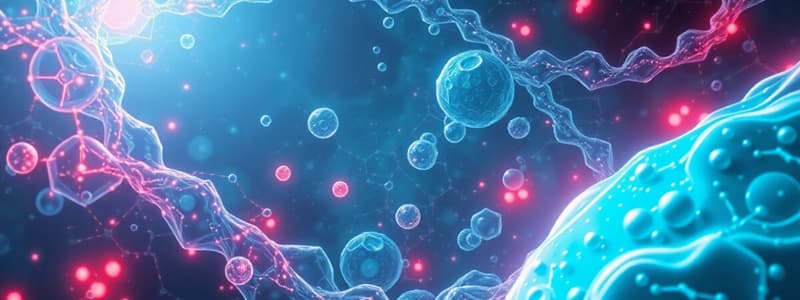Podcast
Questions and Answers
What does it mean for two drugs to be considered bioequivalent?
What does it mean for two drugs to be considered bioequivalent?
- Their rate and extent of bioavailability are not significantly different. (correct)
- They have the same chemical composition.
- They are produced by different manufacturers.
- They cause the same side effects in all patients.
Why is bioequivalence particularly important for drugs with narrow therapeutic ranges?
Why is bioequivalence particularly important for drugs with narrow therapeutic ranges?
- Because they are more affordable.
- Small differences in blood levels can greatly affect effectiveness. (correct)
- They are less likely to produce side effects.
- They have a longer half-life.
What is the primary factor that differentiates chemically bioequivalent drugs from biologically bioequivalent drugs?
What is the primary factor that differentiates chemically bioequivalent drugs from biologically bioequivalent drugs?
- The method of drug manufacturing.
- The presence of different active ingredients.
- The duration of drug action in the body.
- The amount of drug in the bloodstream. (correct)
Which parameters must fall within 80% and 125% to establish bioequivalence?
Which parameters must fall within 80% and 125% to establish bioequivalence?
What is a key clinical implication of highly plasma protein bound drugs?
What is a key clinical implication of highly plasma protein bound drugs?
What does the term 'Tmax' refer to in the context of bioequivalence?
What does the term 'Tmax' refer to in the context of bioequivalence?
Which of the following statements about the bound fraction of drugs is true?
Which of the following statements about the bound fraction of drugs is true?
In the context of plasma concentration of drugs, what does it include?
In the context of plasma concentration of drugs, what does it include?
Which of the following organs is associated with the accumulation of tetracycline?
Which of the following organs is associated with the accumulation of tetracycline?
What does the 'E' in ADME of knowledge represent?
What does the 'E' in ADME of knowledge represent?
What is the primary difference between drug absorption and bioavailability?
What is the primary difference between drug absorption and bioavailability?
Which factor does NOT influence oral absorption and bioavailability of drugs?
Which factor does NOT influence oral absorption and bioavailability of drugs?
What role does first-pass metabolism play in drug absorption?
What role does first-pass metabolism play in drug absorption?
Which of the following factors affects the distribution of a drug in various tissues?
Which of the following factors affects the distribution of a drug in various tissues?
How does ionization at physiological pH affect drug distribution?
How does ionization at physiological pH affect drug distribution?
What is one of the factors that can lead to variation in drug distribution in the body?
What is one of the factors that can lead to variation in drug distribution in the body?
What is the significance of blood flow in drug distribution?
What is the significance of blood flow in drug distribution?
Which characteristic of the blood-brain barrier impacts drug absorption into the CNS?
Which characteristic of the blood-brain barrier impacts drug absorption into the CNS?
What characteristic of the epithelial lining of the gastrointestinal tract mainly aids in drug absorption?
What characteristic of the epithelial lining of the gastrointestinal tract mainly aids in drug absorption?
Why is the absorption of basic drugs delayed until they reach the duodenum?
Why is the absorption of basic drugs delayed until they reach the duodenum?
What effect does food have on drug absorption in the gastrointestinal tract?
What effect does food have on drug absorption in the gastrointestinal tract?
How does capsule or enteric-coated tablet administration affect drug absorption?
How does capsule or enteric-coated tablet administration affect drug absorption?
What is a potential adverse effect related to high peak plasma concentration of a drug?
What is a potential adverse effect related to high peak plasma concentration of a drug?
What role does the efflux transporter P-glycoprotein (P-gp) play in drug absorption?
What role does the efflux transporter P-glycoprotein (P-gp) play in drug absorption?
What is the effect of larger particle size on the rate of drug absorption?
What is the effect of larger particle size on the rate of drug absorption?
What is the primary benefit of modified-release drug formulations?
What is the primary benefit of modified-release drug formulations?
What does a large volume of distribution (Vd) imply about the drug's location in the body?
What does a large volume of distribution (Vd) imply about the drug's location in the body?
Which factor increases the speed of redistribution of a drug in the body?
Which factor increases the speed of redistribution of a drug in the body?
What is the role of efflux transporters like P-glycoprotein at the blood-brain barrier?
What is the role of efflux transporters like P-glycoprotein at the blood-brain barrier?
Which of the following is true about plasma protein binding?
Which of the following is true about plasma protein binding?
What could lead to a clinically significant increase in free drug concentration?
What could lead to a clinically significant increase in free drug concentration?
How does the placental membrane affect drug passage?
How does the placental membrane affect drug passage?
What is a primary function of the blood-CSF barrier?
What is a primary function of the blood-CSF barrier?
What is the significance of competitive binding in plasma protein binding?
What is the significance of competitive binding in plasma protein binding?
What happens when nonlipid-soluble drugs are present in high concentrations in maternal circulation?
What happens when nonlipid-soluble drugs are present in high concentrations in maternal circulation?
What determines the binding affinity of acidic drugs to plasma proteins?
What determines the binding affinity of acidic drugs to plasma proteins?
Flashcards are hidden until you start studying
Study Notes
Drug Absorption
- Definition: The process of a drug entering the body, often through the gastrointestinal tract, and crossing lipid barriers to reach its target.
- Routes of Administration:
- Enteral routes: Oral, sublingual, buccal, rectal
- Parenteral routes: Subcutaneous, intramuscular, intravenous, intrathecal
- Factors Influencing Oral Absorption:
- Dosage forms/Formulation: Capsules and coated tablets can provide controlled-release options.
- Lipid Solubility: Non-ionized, lipid-soluble drugs are readily absorbed from the stomach.
- Degree of Ionization: Basic drugs ionize in the stomach, leading to better absorption in the duodenum.
- First-Pass Metabolism: Drugs metabolized in the liver before reaching circulation can reduce bioavailability.
- Gastric Emptying Rate: Faster gastric emptying can accelerate absorption.
- Intestinal Motility: Increased motility can reduce absorption time.
- Complexation with Gut Contents: Interactions with food or other drugs can affect solubility and absorption.
- Disease State: Conditions like diarrhea or malabsorption can affect drug absorption.
Bioavailability
- Definition: The fraction of an administered drug that reaches the systemic circulation unchanged.
- Factors Affecting Bioavailability:
- First-Pass Metabolism: The extent of metabolism in the liver can significantly influence bioavailability.
- Drug Formulation: Different dosage forms can have different bioavailability profiles.
- Food Interactions: Food intake can delay absorption and alter metabolism.
- Bioequivalence: When two versions of a drug have similar absorption and bioavailability.
Drug Distribution
- Definition: The movement of a drug from the bloodstream to tissues and organs.
- Factors Influencing Distribution:
- Lipid Solubility: Highly lipid-soluble drugs distribute quickly to high blood flow organs like the brain and heart.
- Ionization: Ionized drugs are less likely to cross lipid barriers.
- Plasma Protein Binding: Bound drugs are inactive; only free drugs are available to enter tissues.
- Transporters: Specific transporters can facilitate or limit entry into certain tissues.
- Blood Flow: Organs with high blood flow receive greater drug concentrations.
Volume of Distribution (Vd)
- Definition: A hypothetical volume that represents the amount of drug in the body relative to its concentration in plasma.
- Interpretation: A large Vd indicates that a significant portion of the drug is distributed outside the plasma.
Drug Redistribution
- Process: Initially, highly lipid-soluble drugs distribute to well-perfused organs. As their concentration in plasma drops, they redistribute to less vascular tissues, such as fat and muscle.
Penetration into Brain and CSF
- Blood-Brain Barrier (BBB): Tight junctions in brain capillaries limit the entry of non-lipid soluble drugs.
- Blood-Cerebrospinal Fluid (CSF) Barrier: Similar to BBB, located at the choroid plexus.
- Transporters: Efflux transporters (e.g., P-gp) and other specialized transporters can influence drug entry into the brain.
Passage Across the Placenta
- Placental Membrane: Lipoidal membrane allows passive diffusion of lipophilic drugs.
- Transporters: Placental efflux transporters (e.g., P-gp) can limit fetal exposure.
- Metabolism: The placenta can also metabolize drugs, further influencing fetal exposure.
Plasma Protein Binding
- Binding: Acidic drugs bind to albumin; basic drugs bind to α1-acid glycoprotein.
- Pharmacological Activity: Bound drugs are inactive; only free drugs are pharmacologically active.
- Competition for Binding: Drugs with high affinity for binding sites can displace other drugs, possibly leading to increased free drug concentrations and potential toxicity.
Tissue Storage
- Accumulation: Drugs can accumulate in certain organs due to active transport or binding to specific tissue components.
- Examples: Tetracycline in the liver, iodine in the thyroid, isoniazid in the brain, tetracycline in bone and teeth, thiopentone in adipose tissue.
Studying That Suits You
Use AI to generate personalized quizzes and flashcards to suit your learning preferences.




